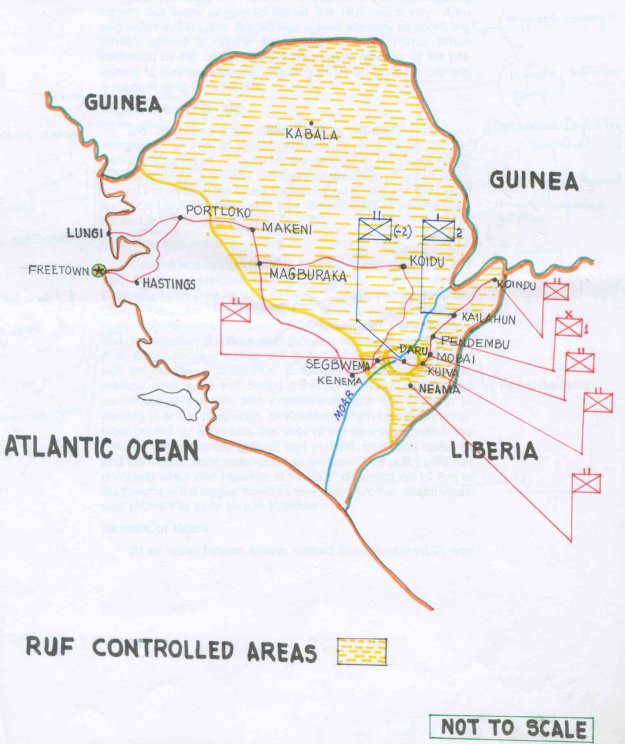
Map I
Home >> Other Operations >> UN Ops >>
VayuSena
© USI Journal, usiofindia.org
By Major Anil Raman
Operation (Op) KHUKRI was an unique multinational operation launched in the United Nations Assistance Mission in Sierra Leone (UNAMSIL), involving India, Ghana, Britain and Nigeria. The aim of the operation was to break the two month long siege laid by armed cadres of the Revolutionary United Front (RUF) around two companies of 5/8 Gorkha Rifles (GR) Infantry Battalion Group at Kailahun by affecting a fighting break out and redeploying them with the main battalion at Daru. Its successful execution displayed the effectiveness of the United Nations and brought it kudos from every corner of the globe. The professionalism and the dedication of the Indian Armed Forces was yet again reiterated for the world to see.
Background to the Conflict
Sierra Leone (see Map I) is located on the west coast of Africa, bounded by the Atlantic Ocean, the Republic of Guinea and the Republic of Liberia. It was a home for slaves and ruled by the British till 1961. Thereafter, it was wracked by tribal strife, which culminated in full-scale civil war in 1991. The participants in this bloody and savage conflict were the RUF and ECOMOG (ECOWAS Monitoring Group. ECOWAS is an abbreviation for Economic Community of West African States). The RUF gained a notorious reputation for brutality and using drugged child soldiers who were particularly savage. This was brought to world attention when on 5 January 1999, the rebels attacked Freetown and held it till 12 January 1999. During their offensive in Freetown, the rebels indulged in indiscriminate slaughter of families, mass rape, burning buildings with people inside, and worst of all, amputated the hands of hundreds of children including infants.

Map I
The Lome Peace Accord
After attack on Freetown, the ECOMOG gained control but were unable to defeat the RUF decisively. After negotiations, the Lome Accord was signed whereby all conflicting parties agreed to disarm, supervised by a United Nations (UN) Force. When requested by the UN, India as a responsible member of the UN, agreed to contribute troops, including an infantry battalion group, engineer company and a medical unit to UNAMSIL.
Organisation of Battalion Group
5/8 GR was selected, redesignated as INDBATT-1, and was reorganised to include two Mechanised Companies of 14 Mechanised Infantry including two platoons of 23 Mechanised Infantry alongwith 116 Engineer Regiment, Signals and Electrical and Mechanical Engineers elements. The battalion also shed two rifle companies which formed the core of the Quick Reaction Company (QRC) and the Guard and Administrative Company. The QRC also had complements of wheeled company and tracked mechanised infantry and 9 Special Force (SF).
Induction and Initial Activities
The unit was inducted into UNAMSIL in December 1999 and by mid April 2000 was deployed deep inside the RUF held territory at Daru (battalion minus two companies) and Kailahun (two companies), 400 kilometres from the capital, Freetown. The battalion had been tasked to assist the Government of Sierra Leone in carrying out disarmament, demobilisation and reintegration of various rebel groups in its area of responsibility. Accordingly, reconnaisance of interior and far-flung regions was carried out with the assistance of the RUF. Extensive civic action, to include medical care, road and bridge construction, water supply and assistance to schools, also commenced, with the intention of winning over the population. In Kailahun, which had been under rebel control for a decade, the state of the people especially the children was extremely pathetic due to malnutrition and diseases and the Indians were worshipped as saviours. This policy paid rich dividends when one battalion of the RUF disarmed on 10 April 2000 at Segbwema in the largest numbers ever seen. Another disarmament was planned in early May 2000 in Kailahun.
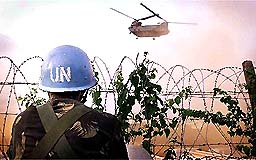
An Indian soldier watches an RAF Chinook land at Freetown, 09 May 2000. (© AFP/Corbis)
Genesis of Crisis
While some tension always existed between the RUF, and the Kenyans and Nigerians, events suddenly turned for the worse when on 01 May 2000 the RUF at Makeni, in the Kenyan Battalion (Kenbatt) Area of Responsibility (AOR), attacked and overran UN forces. Due to a communication gap, this information could not be passed to indbatt in real time, as a result of which, on the morning of 02 May 2000 when the Kailahun company commanders went to meet the local RUF commander about the planned disarmament rally, they were taken hostages. Certain Military Observers (MILOBS) present in Kailahun were also captured. While the capture of their commanders and MILOBS from 13 other countries made it difficult for the companies to take offensive actions against rebels, they manned their defences and steadfastly refused the RUF's demand for their surrender. Based on orders, the Battalion Second in Command (2IC) was despatched with a patrol from the Battalion Headquarters (HQs) at Daru, alongwith the RUF Cease Fire Monitoring Committee (CMC) member, to negotiate the release of the hostages at Kailahun. At Kuiva this patrol was stopped and surrounded by about 200 drugged rebels. As the battalion had experienced similar situations many times earlier during reconnaisance and initial deployment, the 2IC tried to calm the rebels down and began negotiations with their commander. The RUF commander requested the patrol not to go ahead since the situation was extremely volatile. He said that the RUF leadership at Makeni had informed all its cadres that the UN had attacked them. The patrol was detained and, 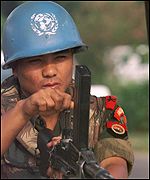 while not being ill treated, and even being permitted delivery of food and movement of persons to Daru, was not allowed to leave as a whole. The hostage crisis at Kailahun was resolved 10 days later through intense pressure put on the RUF commanders by friendly civilians and the officers of INDBATT-1.
while not being ill treated, and even being permitted delivery of food and movement of persons to Daru, was not allowed to leave as a whole. The hostage crisis at Kailahun was resolved 10 days later through intense pressure put on the RUF commanders by friendly civilians and the officers of INDBATT-1.
Situation in the Rest of the Country
By 06 May 2000 general hostilities had broken out all over the western and northern parts of the country and bulk of a Zambian battalion and some troops of a Kenyan battalion (approximately 500 peacekeeping troops in all) were disarmed and taken hostage. As the RUF began moving towards Freetown, the British troops landed to stem the panic and UNAMSIL HQs evacuated most of its civilian staff. The Battalion's QRC was launched to move to Magburaka where more Kenyans had been surrounded. Led by BMPs (tracked armoured personnel carriers/infantry combat vehicle), the company made a lightning 180 kilometres advance through rebel territory. They linked up with the Kenyans and then extricated them after defeating RUF ambushes and attacks. This action which received wide international acclaim and special praises from the Kenyan media, generally went unnoticed in India. This shattering reverse caused the RUF to recoil and the growing British presence in the country caused them to return to their original positions. The capture of their leader Foday Sankoh and mounting international pressure on Liberia were used to secure the release of the remaining UNAMSIL hostages less the Indians. India also inducted additional forces including an infantry battalion and an attack helicopter flight by the end of May 2000.
Factors Affecting the of Use of Force
The extrication of the patrol at Kuiva was well within the capability of the troops at Daru and the plans had been prepared and the forces rehearsed. However, the same could not be executed in the absence of resources required for the extrication of troops at Kailahun. As the strength of UNAMSIL increased, with the arrival of fresh troops, specially the INDBATT-2, Artillery Battery, Special Force (SF) Company and Attack Helicopters, the feasibility of executing successful military operations increased.
The 2IC's patrol was detained at Kuiva for nearly two months amidst intense negotiations at all levels. The patrol was released on 29 June 2000 through Liberia due to international pressure and efforts by the Indian government. Plans for break out of the Kailahun companies took a concrete shape immediately on release of the 2IC's patrol. While the personnel could have been safely extricated in helicopters, the need to bring warlike stores back and question of regimental pride, dictated a fighting breakout.
Design of Battle
The design of battle envisaged the following :-
[a] | Mobilise maximum air effort to concentrate own forces at Kenema and Daru secretly. |
|
|
[b] | Ground offensive from Daru and Kenema and breakout from Kailahun. |
|
|
[c] | Simultaneous engagement of key RUF locations by attack helicopters and artillery. |
|
|
[d] | Selected troops to be helilanded with attack helicopter cover at key locations along the road axis to secure picquets for safe passage of ground column. |
|
|
[e] | Ensure early link up of both the columns at Pendembu and evacuation by air. |
|
|
[f] | Return of all vehicle columns from Pendembu for redeployment at Daru on completion of air evacuation. |
|
|
[g] | Security of Daru to be ensured at all times. |
Deployment of the RUF
The military organisation of the RUF consisted of six brigades under a Defence HQ. Each brigade had four battalions and a "strike" battalion. The cadre consisted of battle hardened and motivated veterans. Each battalion had approximately 960 men and women, divided into four companies of 240 persons each. Each company had four platoons of 60 divided into four squads of 12 to 15 persons. They were equipped with AK-47, RPG-7s, Armoured Personnel Carriers (APCs) and Surface to Air Missiles (SAMs). The 1st Brigade of the RUF, with its HQ in Pendembu, was deployed in own AOR as under :-
| (a) | 1st Battalion | - | Mobai |
| (b) | 2nd Battalion | - | Kuiva |
| (c) | 3rd Battalion | - | Neama |
| (d) | 4th Battalion | - | Koindu |
| (e) | Strike Battalion | - | Segbwema |
Own Troops Available
The troops available for this operation were :-
(a) | INDBATT-1 | : | 5/8GR and two Companies 14 Mechanised Infantry |
(b) | QRC | : | troops of 5/8GR, 14 Mechanised Infantry, 23 Mechanised (Recce and Support), 9 PARA (SF) |
(c) | INDMECH QRC | : | |
(d) | INDENG Coy-2 | : | Company from 7 Engineer Regiment |
(e) | INDSF Coy | : | Company 2 PARA(SF) |
(f) | Indian Aviation Unit | : | Mi-8s, Chetaks and Mi-35s |
(g) | Indian Sector HQ | : | |
(h) | Indian Surgical HQ | : | |
(i) | Forward Surgical Team | : | |
(j) | INDBATT-2 | : | 18 Grenadiers |
(k) | Independent Composite Battery | : | Mortars 120 mm from 310 Light Regiment |
(l) | 2 Companies GHANBATT | : | Ghana Army |
(m) | 2 Companies NIBATT | : | Nigerian Army |
(n) | 2 x Chinhook helicopters | : | UK Royal Air Force (RAF) |
(o) | Elements of D Sqn of the | British Special Air Service (SAS) |
General Outline
The operation was to be conducted in 5 Phases (See Map II):
Phase I | ||
|
Mobilisation and move of combat elements from Freetown/Hastings to Kenema / Daru on 13 and 14 July 2000 by air/road. | |
Phase II | ||
[01] |
Pre-emptive attack helicopters strikes and pre-planned artillery engagements from 0600 hours (h) on 15 July. |
|
[02] |
18 Grenadiers to secure firm base for 5/8GR (Daru column) earliest and secure and hold Giehun by heliborne assault. |
|
[03] |
5/8 GR less 2 Companies (Daru column): (aa) Advance along axis Daru-Kailahun and link up with QRC column at area 3 Bridges (ab)Assist in securing firm base. |
|
[04] |
Kailahun Companies of 5/8 GR. Establish an air head at Kailahun for air extrication of non essential personnel, MILOBs and stores by British forces and prepare to break out by road for link up with SF team. |
|
[05] |
SF team to secure general area North of Kenewa by heliborne assault. |
|
[06] |
QRC column to secure area 3 Bridges by heliborne assault. |
|
[07] |
IND MECH QRC to secure Pendembu. |
|
[08] |
Two companies of GHANBATT to advance from Kenema at 0630h on 15 July 2000 and secure Bendu Junction earliest. |
|
[09] |
NIBATT companies to relieve company of 5/8 GR and hold defended locality in Daru and act as force reserve. |
|
[10] |
One platoon INDENG Company-2 to occupy a platoon defended locality in Daru with effect from 1900h on 14 July 2000. |
|
[11] |
Two CH-47s of the RAF and the SAS to drop Indian SF Company at Kenema and evacuate MILOBS and essentials from Kailahun. |
|
Phase III | ||
[01] |
5/8 GR (Daru column) to secure and hold Pendembu and establish air head. |
|
[02] |
Kailahun column and SF team to link up with Company at Giehun earliest. |
|
Phase IV | ||
[01] |
Link up of 5/8 GR Daru and Kailahun columns at Pendembu. |
|
[02] |
Air extrication of foot columns from air head established by 5/8 GR. |
|
Phase V | ||
[01] |
5/8 GR columns to withdraw tactically to Daru. |
|
[02] |
Other elements to fall back to Daru after passage of 5/8 GR columns. |
|
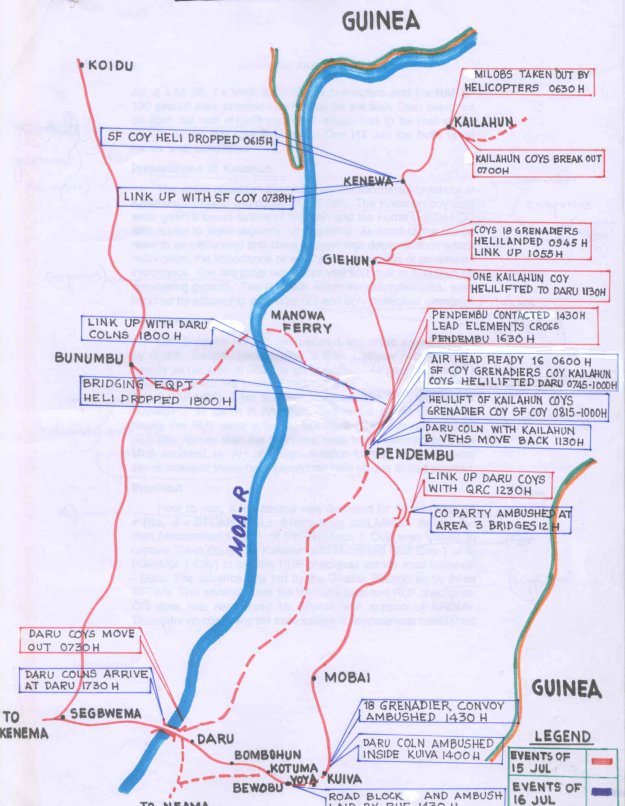
Map II
Mobilisation
The build up at Daru and Kenewa was conducted from 13 to 15 July 2000. 3 x MI-26s, 7 x MI-8s, 2 x Chinook helicopters and 1 x RAF C-130 aircraft were pressed into service for the task. Daru being cut off from the rest of government controlled areas, had to be built up by helicopters. By the last light of D minus one (14 July 2000) the build up of forces was completed.
Preparations at Kailahun
The entire operation depended on the successful breakout of Kailahun companies and extrication of MILOBs. The Kailahun company commanders were given a broad outline of the plan and the force commander and commanding officer (CO) also spoke to them regularly on satellite phone (satphone). As most of the troops were to be helilanded and close support was dependent on attack helicopters, the weather conditions for flying were of paramount importance. The two companies were deployed 500 metres from Kailahun on dominating ground . Two helipads within the defended area, were secured by occupying perimeter defence and deploying protective elements.
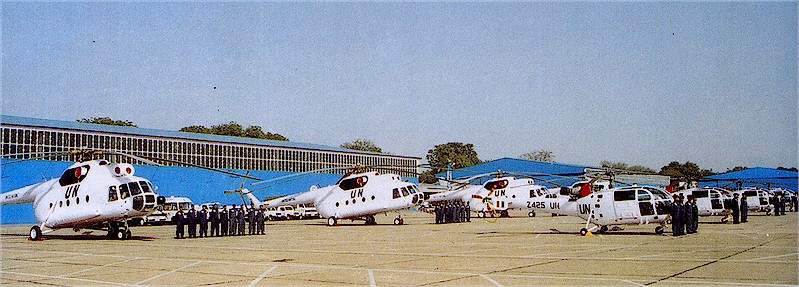
The first batch of helicopters sent to UNAMSIL, a set of four Mi-8s and Chetaks each
are lined up for inspection at Palam New Delhi before being despatched to Sierra Leone.
The Mi-35s were sent later when it was flet that more dedicated firepower was needed.
Air Extrication
On 15 July 2000, the helipad was secured and entire area sanitised by 0600h. Despite bad weather, two RAF Chinook helicopters landed exactly as per plan at 0620h and extricated 44 personnel including 11 MILOBs and war like stores. Enroute the same helicopters had dropped Company 2 PARA(SF), two kilometres South of Kailahun. The RUF had approximately 300 to 400 of its cadre in Kailahun. Due to the arrival of Chinook helicopters the RUF were activated but were effectively engaged by own fire. As per plan the Chinooks were to be followed by three MI-8 escorted by attack helicopters (AH) of Indian Aviation Unit to extricate more stores, however, these helicopters could not take off due to bad weather.
Breakout
Prior to move, a fire assault was delivered for 10 minutes employing fire power of rocket launchers, armoured personnel carries, automatic grenade launchers, 51 mm mortars and medium machine guns. As per the plan Mechanised Company-1 of 5/8 GR (Mech 1 Company) was tasked to capture Town Square in Kailahun and Motorised Rifle Company-1 of 5/8 GR (Mot 1 Company) to capture RUF checkpost astride road Kailahun - Daru. The advance was led by the Ghatak (Commando) Platoon supported by three armoured reconnaisance vehicles (BRDMs). The advance drew fire from QG area and RUF checkpost. QG area was neutralised by Ghatak with support of BRDMs. Thereafter on contacting the town square, a fire base was established by Mech 1 Company and Mot 1 Company assaulted the check post with the Town Square as their forming up place (FUP). The advance of Mot 1 Company towards the barrier came under heavy fire from the RUF but the fierce assault closed in and soon secured the check post. Immediately, the B vehicle column moved out and link up was established with Company 2 Para by Mot 1 Company at the barrier. The fire base at Town Square in Kailahun continued to be in position till all elements had crossed and then disengaged by fire and move. The column quickly advanced towards Giehun with Company 2 Para and BRDMs covering the tail. At around 0930h the attack helicopters arrived and thereafter it was easy to break contact from the RUF who by now had reorganised and were continuously sniping at the rearguard. Around 1030h the road column arrived at Geihun to link up with the INDBATT-2 Company which had been helilanded earlier. The Force Commander landed at Geihun to meet the troops and ordered the helilift of 60 troops to Daru.
Move to Pendembu
After reorganising, the column moved on and encountered two major road blocks in the form of 8 feet wide and 4 feet deep ditches dug on the road covered by small arms and rocket launcher fire. Continuous sniping by rebels and slushy conditions on the road impeded progress. The area was physically secured and bridging stores carried by the column and those dropped by an MI-8 helicopter facilitated speedy bridging. The column met the linkup force under the CO 5/8 GR Battalion Group about 5 kilometres from Pendembu at 1700h, D Day. Thereafter the entire column moved to Pendembu and was directed to deploy in respective areas of the battalion harbour for the night.
Actions of Daru Link Up Force
The insertion of SF Company and extrication of MILOBs from Kailahun at 0620h signalled the commencement of operations of forces located at Daru. 18 Grenadiers advanced and secured a firm base in conjunction with the Infantry Combat Vehicles (ICVs) of 5/8GR Battalion Group and artillery bombardment.
5/8 GR Advance to Pendembu and Link Up with QRC
5/8 GR columns ex Daru commenced advance immediately on securing of the firm base with the ICVs of Mech-2 Company leading. At approximately 0830h the lead elements came under heavy fire from North of the road 500 metres short of Tikonko. ICVs effectively neutralised the fire and the advance continued. The column again drew fire from houses in Bewobu (RUF Company location) but burst through with all guns blazing. At Kuiva, heavy small arms fire was encountered from jungle on either side of the road and the village. It was initially planned to physically secure and search Kuiva, but the progress of Kailahun columns indicated a possibility of link up and air evacuation on the same day. Therefore, CO decided to continue to advance with speed for Pendembu. Supported by battalion mortars, the column crossed the town by fire and move. The rebels had taken up positions inside the village but after offering initial resistance, fled into the jungle in face of accurate fire leaving ammunition scattered behind. The column moved at good speed suppressing small arms fire using its ICVs. In the meantime, the battalion's QRC was lifted from Daru in two waves of 3 x MI-8s each and captured Area 3 Bridges by heliborne assault. Maintaining momentum, the 5/8 GR column advanced at high speed to link up with the QRC. Enroute a rebel vehicle full of arms and ammunition was chased by the ICVs and recovered by Mot-2 company. At 1230h the link up was established with the QRC and thereafter the battalion column started to deploy on the southern edge of Pendembu.
Securing of Pendembu
Pendembu was the HQ of RUF's No 1 Brigade and its stronghold in the east and a pitched fight was expected. The town was about one kilometre in length and had solid single storeyed cement houses. Tall grass along the road and inside made it ideal for ambushes.
An attack helicopter directed to strafe Pendembu made fivepasses at 1300h and carried out pin point engagement of the known RUF locations in town. In the meantime, the Battalion mortars deployed north of Bridge 3. The CO reviewed the plans and chose Mot 2 Company, to secure the complete built up area of nearly 300 houses and an air head in the south west (SW) portion of Pendembu. First to secure the northern flank, Mech-2 company moved through with all guns blazing and occupied the north edge of the town. Thereafter, the Mot-2 company began its operations by first silencing heavy fire from the SW of the town using ICVs and then using its rifle platoons to clear the houses systematically. A massive RUF cache of arms and ammunition was found. Some rebels were killed in the SW portions by 4 Platoon of Mot 2 Company and more were killed while clearing the armoury by 6 Platoon. Later a suitable airhead was selected along the Pendembu - Daru road. The QRC Company linked up to the SW of Pendembu. Soon thereafter, companies were reorganised, areas allotted and preparation of temporary defences for the night commenced.
Link up with Kailahun Column
At about 1630h the CO led a column to the link up site. The advance through dense jungle was done by boldly employing ICVs and link up was established with the Kailahun party at about 1730h. This column was escorted to Pendembu by about 1900h.
Pendembu Night 15/16 July 2000
Officer Commanding (OC) QRC coordinated the defences at Pendembu and on arrival, the Kailahun columns were guided to their respective areas of responsibility. Throughout the night ,the RUF who tried to probe the defences were, much to their discomfiture, accurately engaged by own fire. The 105mm Light Field Gun (LFG) and the battalion mortars were used to engage likely routes of RUF reinforcements throughout the night.
Helilift Operations
By 0700h Mot 2 Company prepared a helipad and troops earmarked for helilift started to upstick as per their deinduction schedule and the defences were readjusted. The MI-8s started arriving at the helipad at 0815h in a continuous stream. A total of 12 sorties were flown. Mech 1 Company, Mot 1 Company, SF Company, D Company 18 Grenadiers and QRC Company (two Platoons) were deinducted. The last helicopter took off at 1030h.
At about 0930h own troops, deployed to the north of the town reported 50 to 60 armed RUF cadres moving towards the platoon post along the road. They were effectively engaged by an armed helicopter directed by the Adjutant acting as an Air Control Team (ACT). Later, selected RUF bunkers in basement of buildings and their ammunition storage centre were demolished with help of the battalion engineers.
Move Back to Daru
After the last helicopter took off for Daru, the road column comprising of Daru companies, QRC company less two platoons and vehicles of Kailahun Companies started to reel in as per their order of march with Mot 2 Company leading. The Mech 2 Company was told to hold on to the north edge of the town till the last and bring up the rear of the column after conducting a tactical disengagement. Continuous overwatch and intimate fire support was given by one MI-35 helicopter at all times till the column reached Daru. While crossing area 3 Bridge, the CO's party came under fire. The command BRDM was effectively used to silence the fire. The column reached Kuiva without incident. Speculative fire was brought down at all suspected locations by the leading ICVs. The troops deployed for the firm base also started reeling in as 5/8 GR moved back.
Kuiva Ambush
The column had been cautioned to expect a road block cum ambush near Kuiva based on information from radio intercepts and intelligence. At about 1400h scout helicopters also reported that the road had been dug up between Bewabu and Kuiva. At Kuiva, which had been secured by a company of 18 Grenadiers, the CO ordered a halt as the column had extended over a long distance. Suddenly, the column was engaged by rocket launcher (RPG) fire from very short range and a rifle platoon supported by ICVs had to be used to drive the rebels away.
Bewabu Ambush
The column then moved ahead with caution towards Bewabu and at about 1430h, the leading ICVs, short of Bewabu came across a ditch covered by heavy small arms fire from high ground on both sides of the road. The Mot 2 Company Commander, moving just behind the second ICV of the column realised at once that the column was in the killing ground of the ambush. Immediately Number 4 rifle platoon following just behind was ordered to counter ambush on the high ground supported by ICV fire. The firefight continued for next 15 minutes. Attack helicopters were also tasked to strafe both sides of the road to deter the rebels from further interference. Number 6 platoon and the battalion's engineer platoon immediately set about bridging the gap.
Mobai Ambush
While the head of the 5/8 GR column was engaged in tackling the Bewabu road block, the 18 Grenadiers column was following up about six kilometres behind with 2x BMPs of Mech-2 and 2x BRDMs of Mech-1,at the end of the convoy. This convoy, came under heavy fire short of Kuiva. After 10 minutes of exchange of fire, the troops again mounted the vehicles and advanced. After about 500 metres of move, a vehicle carrying artillery ammunition had a direct RPG hit. A Chetak helicopter flew in to pick up the casualty from Kuiva.
The entire convoy thereafter moved at high speed without encountering any resistance and carrying out speculative fire where necessary. With the MI-35 helicopters also providing intimate fire support the convoy made good speed and reached Daru at 1730h.
Synergisation of all Available Assets. Op KHUKRI was a classical example of synergy of effort. The optimum utilisation of all resources , joint planning (Indian Army, IAF, UNAMSIL forces and the British Forces)and execution resulted in a synergy that multiplied the effectiveness of the assets deployed.
Simultaneity of Operations. Commencing operations simultaneously from Kenema, Daru and Kailahun, and helilanding troops at three places enroute caused utter confusion in the RUF.
Real Time use of Human Intelligence (HUMINT) and Signal Intelligence (SIGINT). During the planning of rescue mission from Kuiva, Pendembu and Kailahun, non availability of air/satellite imagery was a big handicap. The Intelligence Non Commissioned Officer (NCO) of 5/8 GR made nine trips with the ration convoys to covertly note RUF strength, deployments and obtain Global Positioning System (GPS) fixes of RUF targets. This intelligence was later used by the artillery and attack helicopters to engage targets. The Battalion radio monitoring cell did an outstanding job in monitoring RUF communications throughout the three months to build up a clear picture of the RUF activities. Real time monitoring of RUF communications during operations gave a picture of RUF actions regarding move of reinforcements and preparation of ambush/road block sites. These were passed on to the columns and to attack helicopters for verification and engagement.
Good Intelligence of RUF Activities and Intentions. The painstaking study of RUF tactics, organisation, personalities of leaders and updating of activities helped to anticipate reactions correctly.
Deception and Security During Build Up. RUF was successfully kept in the dark about the build up. The RUF was made to believe that the battalion was being replaced hence additional troops were coming as relief. No operational messages were passed on radio and only satphones were used. The unit had made own codes and nick names for places and personalities. All conversation was in Hindi and Gurkhali and for further secrecy, plans were passed over satphone to Kailahun in colloquial Malayalam.
Flexibility in Conduct. The plan had an inherent capacity to be changed as per the progress and situation. The presence of the Force Commander at Daru helped further, as decisions were taken on the spot.
Maintenance of Momentum. Relentless advance by Daru columns and brushing aside ambushes without dismounting added to the speed of advance. Not changing the leading companies at Kuiva and Mobai as planned ensured momentum.
Resolute and Competent Junior Leadership. Op KHUKRI was a series of subunit actions fought independently. The exemplary leadership displayed by junior leaders was infectious and added to the potency of the force.
Use of ICVs to Lead Advance and Break Ambushes. Notwithstanding the dense jungle, ICVs were used to lead the advance. Their mobility and high volume of fire enabled the columns to proceed without dismounting at most of the ambush sites.
Attack Helicopter Support. The attack helicopter was one of the most potent assets and proved very effective in breaking ambushes as well as denying free movement of rebels on the road by day. Combat Air Patrol (CAP) provided to the returning road column on 16 July 2000 was instrumental in its safe return.
Conclusion
The success of Op KHUKRI was felt not merely in its tactical terms. It gave the RUF its worst defeat in recent history and at the same time gave a tremendous boost to the UNAMSIL forces in particular and to the UN as a whole. The detractors of the UN were silenced and the potential of this noble institution was once again displayed. The greatest reward for the Indian Peacekeepers was the rapturous reception given to them by the people of Daru as they came triumphantly back from battle. It was the welcome of a long suffering and desperate people who understood that there were people in this world who would shed their blood for them. Perhaps, that is why they helped build the KHUKRI Memorial in Daru barracks overlooking the Moa River.
Major Anil Raman is from 5/8. Gorkha Rifles. He was adjutant of the Battalion Group in UNAMSIL.
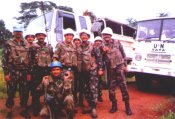 | Colonel Khushal Thakur, YSM, CO 18 Grenadiers, with his team after the successful rescue operation of the trapped soldiers from Kalaihun, Sierra Leone, July 15, 2000. Operation Khukri was initially code-named Operation Kassava. |
 | Defence Minister George Fernandes congratulating Colonel Khushal Thakur at Hastings, Sierra Leone on July 20, 2000. |
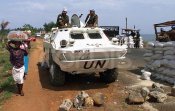 | Indian Army troops on deputation to UNAMSIL guard a checkpoint in Freetown. The vehicle (UNAMSIL 1218) is a BRDM fast recce vehicle. (May 07, 2000) |
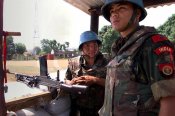 | Gorkha troops of the Indian Army man a Bren Light Machine Gun at a post in Freetown. The Gorkhas are considered to be among the world's finest soldiers. (May 06, 2000) |
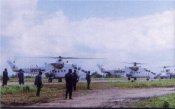 | Three Mi-35 Gunships on the ground in Sierra Leone. Two temporary UN serial numbers alotted to the aircraft are visible - UN110 and UN112. Courtsey Bharat Rakshak |
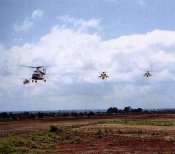 | A Mi-8 is followed by three IAF Mi-35 gunships; photographed in Sierra Leone. Courtsey Bharat Rakshak |
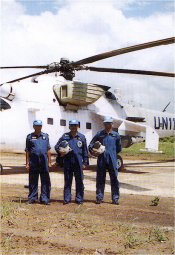 | Some IAF personnel pose infront of an IAF Mi-35. Courtsey Bharat Rakshak |
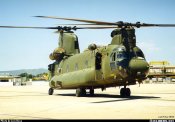 | Faro, Portugal: A RAF Boeing Vertol Chinook coming from Sierra Leone en route to UK. These aircraft were not given UN colours, since the British troops were not under the UN mandate. Photographed June 2000 © Luis Rosa/Airliners.net |
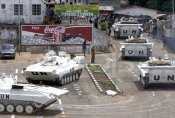 | Indian BMP-2s and troops arrive in Freetown's port on May 21, 2000. Photo by Yannis Behrakis © REUTERS/corbis.com |
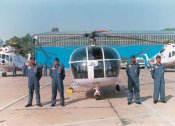 | The Indian contingent at Palam before being despatched to Sierra Leone. (MoD) |
| Other Ops and Incidents | : | Assorted Photos from other UN Missions |
| Other Ops and Incidents | : | IAF in MONUC, Congo |
| 1980s | : | Photofeature: Operation Cactus |
| Other Ops and Incidents | : | COIN operations in Ceylon - 1971 |
| bharat-rakshak.com/IAF/History/2000s/Sierra.html: IAF in Sierra Leone. Lots of rare pictures. |
| abc.net.au/foreign/stories/s433773.htm: Transcript of a Australian Broadcasting Corporation (ABC) documentary on mercenary aviation in Sierra Leone. |
Created On: 24.Dec.2003

Comments or Questions? Contact Us
[Home] [The IAF Today] [Other Ops & Incidents] [Kargil 1999] [1980s] [1971] [1965] |
| Top |